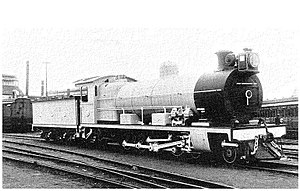NGR Hendrie D
| NGR Hendrie D SAR Class 3 (3R) |
|
|---|---|
|
NGR No. 332, later SAR class 3 No. 1448
|
|
| Numbering: | SAR: 1446-1475 |
| Number: | 30th |
| Manufacturer: | North British |
| Year of construction (s): | 1909-10 |
| Retirement: | 1974 |
| Type : | 2'D1 'n2 |
| Gauge : | 1067 mm ( cape track ) |
| Length over coupling: | 19,266 mm |
| Service mass: | 84.3 t |
| Service mass with tender: | 125.5 t |
| Wheel set mass : | 15.3 t |
| Driving wheel diameter: | 1,156 mm |
| Cylinder diameter: | 533 mm |
| Piston stroke: | 610 mm |
| Boiler overpressure: | 130.9 N / cm² |
| Grate area: | 3.16 m² |
| Train brake: | Suction air brake |
The vehicles of the type Hendrie D of the Natal Government Railways (NGR) were a Tender steam locomotives with the wheel arrangement 2'D1 '( Mountain ), the first in South Africa, which had been designed from the start with this wheel arrangement.
The 30 locomotives built by the North British Locomotive Company were intended for use on the less inclined upper part of the Natal Main Line between Durban and Transvaal for heavy coal traffic.
The Hendrie D was an extended version of the 2'D locomotives of the Hendrie B type . The standing boiler was now arranged behind the coupling wheels and could therefore be made more spacious - but the grate area remained the same. A trailing axle was required to support the overhanging weight. The coupling wheel diameter remained unchanged from the Hendrie B, and the cylinder diameter was increased by half an inch (12.7 mm).
The Hendrie D were still wet steam locomotives. In 1909 the NGR procured a test locomotive built in the USA with a superheater (called the American D ), and when more Mountains were needed, a superheated version of the Hendrie D was created, which in 1912 - already under the direction of the South AfricanRailways (SAR) - as class 3B was put into service.
The wet steam machines were adopted by the SAR as class 3 . In the 1930s they received new standard boilers and were designated as class 3R (R as in reboilered ).
In later years the locomotives were mainly used for shunting, especially in and around Cape Town and Bloemfontein . In 1970 they were concentrated in the Cape and retired until 1974. No. 1453 has been preserved as a monument locomotive.
literature
- Leith Paxton, David Bourne: Locomotives of the South African Railways. A Concise Guide. C. Strui (Pty) Ltd., Cape Town 1985, ISBN 0-86977-211-2 .
Web links
- Technical data and illustration of SAR class 3 (English)
- Technical data and illustration of SAR class 3R (English)
Individual evidence
- ↑ Heinie Heydenrych, Bruno Martin: The Natal Main Line story . HSRC Publishers, 1992, ISBN 0-7969-1151-7 , pp. 111 .
